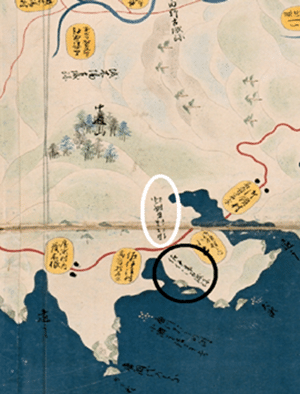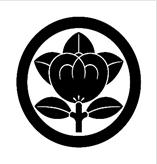
History of Amakusa city (1st - 2nd chapter)
Hama-su, Su-nosaki and Myo-se
I would like you to be interested in Saitsu village and Saitsu-jinja shrine (also known as Saitsu Jugoshagu Shrine).
The origin of the name of the village has not been identified clearly, but they say that the name Saitsu was corrupted from the name San-zu. According to our local lore, in ancient times the land had consisted of three sandbanks until a movement of the earth's crust occurred. Three is "san" and sandbank is called "su", "zu" or "se" in Japanese. They remain in names of three areas of Saitsu, Hama-su, Su-nosaki and Myo-se.
Saitsu village was located in the North-East coast of Shimoshima in the Amakusa district, Higo Province, Kumamoto Prefecture. It was bordered by Simabara Coast to the East, Goryo Village to the North, Jogawara Villge to the West and Hondo Town to the South. It covered 67.9-80 square kilometers. The village was encircled by slopes which were about 70-80 meters higher than the plain area. The eastern part and the central part of the village were low-lying land. The sea was shallow off the shore. The village had a long coastline. It was blessed with warm weather and a natural harbor formed by the bay. Therefore the village developed earlier than other places around it.
The name of the Saitsu first appeared in a document that stated orders (Shiki document) dated on August 22th, 1212. There is written that "Saitsu-Sawabari". Sawabari means a marshland. On the map of the day Saitsu and Saitsu-Sawabari are displayed in different places.
In 1212, Mitsuhiro Shiki
In 1212, Mitsuhiro Shiki, who wrote the Shiki document, was appointed to Jito (an agent in charge of a lord's manor) of the area of Amakusa-Mutsugaura including Saitsu Village. In 1303, Kagemitsu Shiki transferred half of Saitsu to Yasuhiro Saburo and gave the other half to his heir Kagehiro Shiki and allowed him to govern the area directly. Saitsu Village was located near Hondoto Island ruled by Amakusa Clan, so it can be supposed that Shiki Clan designed to expand their sphere of influence to the island by having a base of operations in Saitsu area.
Shiki Clan had two castles in Saitsu Village named Saitsu-Takayama Castle and Saitsu-Kanahama Castle, which were the two most important ones of eight castles they had (See figure I and II). They worked both as via points with Oura (Ariake-cho) and as a line that is defended to prevent Amakusa Clan from invading.
Saitsu-Kanahama Castle
In Edo era, Terasawa Clan of the Karatsu domain (equivalent to Saga prefecture today) started to rule Amakusa as outland. A castle was constructed in Tomioka, north part of Amakusa, to govern entire Amakusa. Judging from the architectural form of Castles in Saitsu, Terasawa clan seems to have renovated their castle using new technology at that time like a stone wall.
Kanahama Castle’s stone wall remains today, and was designated as cultural property of Amakusa city on June 13th, 1975.

Figure I

Figure II
Tempo-Ezu: Higo Province The list of castles in Higo Province (the
surrounding part is Saitsu-Takayama Castle and Saitsu-Kanahama Castle)
Kanahama Castle’s stone wall is about 5 meters high. This is the only existing building belonging to the castle, so it is precious cultural heritage. A feudal retainer of Karatsu Domain Tazaemon Namikawa wrote that in Amakusa there were six castles including Tomioka Castle. He describes Kanahama Castle as Saitsu Castle. Judging from a picture of the day, Saitsu Castle had also a castle tower. The castle could be well guarded with stone wall and a castle tower.
According to the board of education of Amakusa city, the edges and upper part of the wall are already broken, and the wall is rare case as one of old remains because it has a loophole leading to the center of the castle. Hara Castle, famous for Shimabara war, is also said to have had a loophole, but this report will not take up the subject here.
Saitsu-Takayama Castle
About Saitsu-Takayama Castle, there remains only a data of the income coming from rice, so the description below is only speculative.
On October 24th, 2015, I did field work with Hinokatsu Nakatsu, who belongs to the tourist office of Amakusa. We visited the place where he supposed the castle was located on the basis of some oral traditions (at 32º29'42.89'' north latitude and 130º10'56.87'' east longitude). The place was a hill of 30 meters in height with a fine view. In the remained site there is a house, which has stage name “Jou” (which means castle in Japanese). The member of the family used to be called “Mr. Jou”, and they say that there is stage name “Banguchi” (which means a gate keeper) around there. In this place, we were not able to find something remained like Kanahama Castle’s stone wall. If the research of buried cultural properties is conducted, articles concerning Shiki Clan or Terasawa Clan may be found.
Saitsu Jugoshagu Shrine
Next, I would like to introduce Saitsu Jugoshagu Shrine. Historical sources on the shrine were burned down because of a great fire in Saitsu Village in 1869. The following explanation is based on the notes written by a Shinto priest of a past generation, Hikojiro Yamada.
The 1st Fujiwarano-Tsunemoto Yamada Naiki (a governmental post of court secretary)
The 2nd Fujiwarano-Tsuneyoshi Yamada (governor of Tango)
The 3rd Fujiwarano-Tsunenobu Yamada (governor of Izumi)
The 4th Fujiwarano-Tsuneyoshi Yamada (governor of Tango)
The 5th Fujiwarano-Tsunenao Yamada (governor of Tamba)
The 6th Fujiwarano-TsuneFusa Yamada (governor of Tamba)
The 7th Fujiwarano-Tsunetaka Yamada (governor of Kazuma)
The 8th Fujiwarano-Tsunekiyo Yamada (governor of Kazuma)
The 9th Fujiwarano-Tsunetsugu Yamada (governor of Naizen)
The 10th Tsunesada Shuzen Yamada
The 11th Hikojiro Yamada
The 12th Yoshito Yamada
The 13th Yasuto Yamada⇒The present chief priest of the Saitsu Jugoshagu Shrine.
The member of Yamada family and Shiki Clan have a same kanji “経” in their name in common, which may suggest that they are related somehow.
The following are the deities Saitsu shrine is dedicated to.
Amaterasu Omikami (the goddess of the sun or universe)
Emperor Jinmu
Kamuyaimimi no mikoto (a son of Emperor Jinmu)
Twelve Gods of Aso
The 1st Takeiwatatsu no mikoto
The 2nd Himegami
The 3rd Kunitatsu no kami
The 4th Hime no kami
The 5th Hikomiko no kami
The 6th Wakahime no kami
The 7th Nihiko no kami
The 8th Nihime no kami
The 9th Wakahiko no kami
The 10th Yahime no kami
The 11th Kuninomiyatsukohayamikatama no kami
The 12th Kanakori no kami
According to the description on the back of the statues of Japanese god lying in the main shrine building, they were created in 1863 by Kiyota Akao. Although another statue, whose face is scraped off, has been discovered, but the details are unclear because nothing is written on that. They were made in 1863, so when the great fire broke out in Meiji era, they must have been rescued so that they would not burn out.
Christian in Saitsu
Although there are few books dealing with Christian in Saitsu, we have researched about it while doing the field work.
It was after June, 1599 that a residencia (quarters for a monastic order), and father Balthazar Lopez the older was in charge of this. He was born in Spain in 1545 and came to Japan in 1577. He majored in philosophy. Before coming to Saitsu he belonged to the Oyano church.
“The older” was adopted to his name to distinguish him from whose first and last names are the same as his. The other was called Balthazar Lopes the younger. When seminario and collegio are written in kanji, “小” is used for the former and “大” for the latter. These are also used for express “the younger” or “the older”, so this way to call two Balthazars in Japanese can have something to do with theological schools.
There were two kinds of residencia. One is belonged to collegio and it had one abbot and one auditor or superior. Another was an independent institution governed directly by a ward mayor of the district. Which the one that used to be in Saitsu is is unknown due to the insufficient historical information.
The first residencia in Amakusa was built in Shiki, and as the teaching spread, they were put in each area to be bases of Christians’ religious lives. Residencias eventually were established in almost entire land of Amakusa.
There was a martyr in Saitsu, named Sotelo Kudo. He escaped from Saitsu Village and died in Kuchinotsu in 1614. The Kudo clan remain in two families in Saitsu today.
There is written in 熊本県歴史の道調査―天草路道―[Historical Roads in Kumamoto: Amakusa Road] that
If one turns right at the Amida Temple and goes straight for 200 meters, and turns left along the road, there is a narrow path, the entrance to Goryo Street. It is 1 meter wide today, but it used to be 3 meters wide. As one goes, the road widens to 4 meters wide, and there is a bamboo grove on the right. At the end of the road, there is a made land with a fine prospect. On the hill which is 200meters west from the land, there are eight Christians’ tombs among normal ones. On the surfaces of three of those, you can see crosses.
But it was difficult to see them while doing field work.
Receiving information from Mr. Hirata that there are 64 tombs including six ones in Matsubara area, we took an additional research and discovered many tombs of Christians in two places, Zaigo area (at 32º29'46.17'' north latitude and 130º10'59.65'' east longitude) and Terano-o area (at 32º29'28.74'' north latitude and 130º10'38.99'' east longitude).
Some tombs are plain-boarded and with crosses engraved on them, or on other ones figures of a person wearing a rosary or having a cross on her forehead are carved. This can be because many people in Amakusa worshipped the Virgin Mary. Around these tombs, there seemed to be many ones with a family crest indicated in figure III. Although it may be a strained interpretation, the crest looks like a cross, so Christians in hiding can have used it when they worshipped.
The above is the introduction to Saitsu. However, many things regarding the history of it is still unknown because few source materials about the periods remain. I would like to continue studying about it hoping the region development, and to pass on to posterity.

Figure III
Thank you for reading. If you want to know more please email ; )
saitsujinja@yahoo.co.jp
この記事が気に入ったらサポートをしてみませんか?

